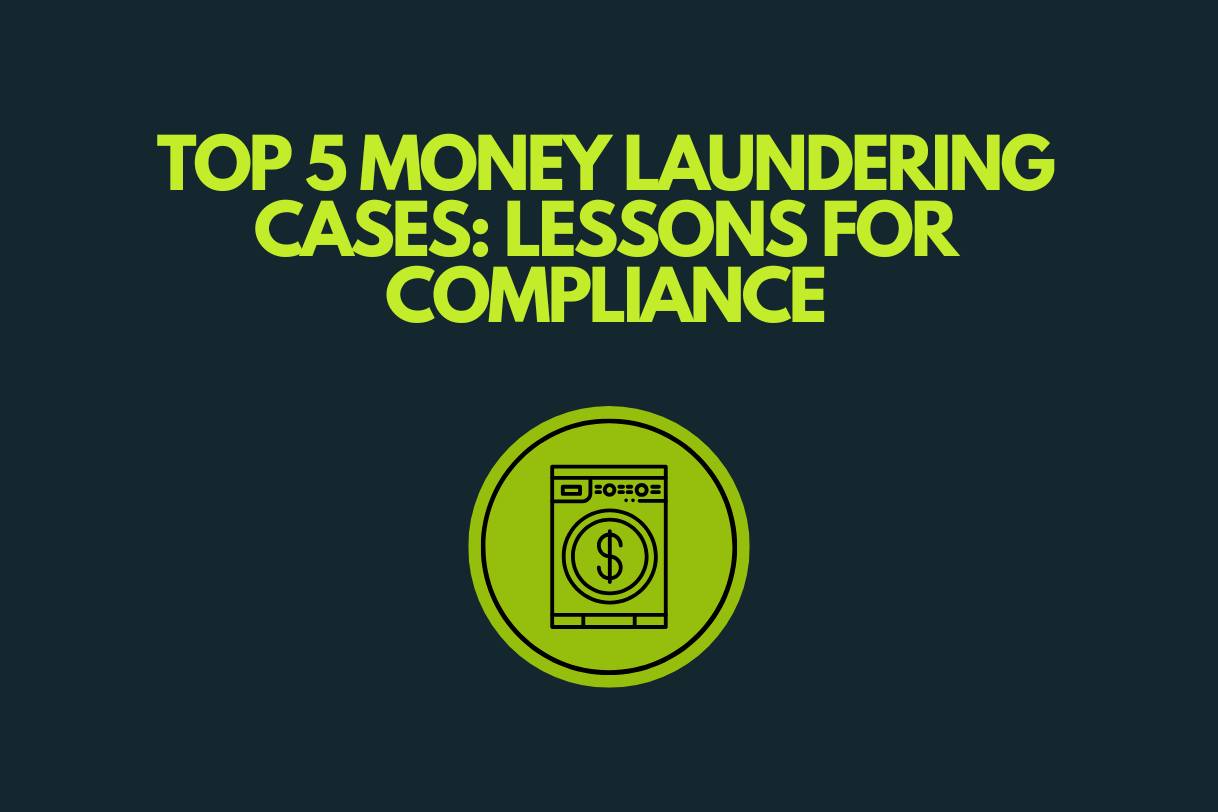
Case Study: Top 5 Money Laundering Cases
Explore five of the biggest money laundering cases in history — from Danske Bank to HSBC — their staggering costs, impact on companies, and the compliance lessons they reveal.
Money laundering is one of the most pervasive financial crimes in the world, costing trillions of dollars each year and undermining trust in the global financial system. Behind every headline lies a cautionary tale of weak controls, poor oversight, and the devastating consequences of compliance failures.
This case study examines five of the most significant money laundering cases to date — who was involved, what went wrong, how much it cost, and what compliance professionals can learn to prevent history from repeating itself.
{{snippets-guide}}
1. Danske Bank – The €200 Billion Scandal

Overview:
Between 2007 and 2015, Danske Bank, Denmark’s largest lender, became the center of one of the biggest money laundering scandals in history. Its Estonian branch processed approximately €200 billion (about $230 billion USD) in suspicious transactions originating primarily from Russia and other ex-Soviet states.
What Happened:
Investigations found that Danske’s Estonian branch had lax anti-money-laundering controls. Many of its non-resident clients — companies registered in the UK, Cyprus, and the British Virgin Islands — were used to funnel funds of unclear origin.
Whistleblower Howard Wilkinson, a former employee, first alerted executives in 2013, but internal warnings were ignored. When the scandal broke publicly in 2018, global regulators launched coordinated investigations.
Cost and Consequences:
- In 2022, Danske Bank pled guilty in the U.S. to fraud and agreed to pay $2 billion in penalties.
- The bank’s CEO resigned, its share price dropped nearly 50 %, and its reputation as a trusted Nordic institution was shattered.
- It faced lawsuits from investors and lost access to international markets for several years.
Key Lessons:
- Non-resident and cross-border accounts require enhanced due diligence (EDD).
- Ignoring internal whistleblowers can turn small problems into systemic crises.
- Regulators now expect banks to prove not only that they have AML policies, but that they actively monitor their implementation.
2. HSBC – The Drug Cartel Money Laundering Case

Overview:
In 2012, global banking giant HSBC admitted to allowing Mexican drug cartels and sanctioned entities to launder nearly $881 million through its U.S. subsidiary. The case became one of the most notorious examples of compliance failure in modern banking.
What Happened:
HSBC’s AML program was woefully inadequate. Its Mexican affiliate shipped billions in cash to the U.S. without proper checks, and compliance officers failed to monitor high-risk transactions. The bank also processed payments for Iranian, Sudanese, and North Korean entities in violation of U.S. sanctions laws.
The U.S. Senate’s Permanent Subcommittee on Investigations later revealed that compliance staff were under-resourced, risk alerts were ignored, and suspicious activity reports were not filed in time.
Cost and Consequences:
- HSBC paid $1.9 billion in fines and entered into a five-year deferred prosecution agreement (DPA) with the U.S. Department of Justice.
- It had to submit to independent monitoring and implement sweeping AML reforms.
- The scandal damaged its standing with regulators and investors worldwide.
Key Lessons:
- AML programs must have independent authority and adequate resourcing.
- Sanctions compliance and AML are intertwined — weak controls in one expose risk in the other.
- DPAs and corporate monitorships are costly both financially and reputationally; prevention is far cheaper than remediation.
3. 1MDB – Malaysia’s Billion-Dollar Corruption Scandal

Overview:
The 1Malaysia Development Berhad (1MDB) case exposed a vast corruption network involving Malaysian officials, international banks, and politically connected individuals. Between 2009 and 2014, more than $4.5 billion was siphoned from the sovereign wealth fund into personal accounts and luxury assets around the world.
What Happened:
Funds meant for national development projects were diverted through shell companies and offshore accounts. The money financed extravagant purchases — real estate, art, a yacht, and even the production of the film The Wolf of Wall Street.
Key figures included Jho Low, a Malaysian financier, and associates of former Prime Minister Najib Razak, who was later convicted of corruption. Global banks such as Goldman Sachs, BSI, and Falcon Bank were implicated for facilitating transactions without adequate due diligence.
Cost and Consequences:
- Goldman Sachs paid $2.9 billion in global penalties, one of the largest fines ever for a financial institution.
- Several Swiss private banks lost their licenses.
- Malaysia’s political landscape was upended, and trust in public institutions plummeted.
Key Lessons:
- Political exposure demands enhanced due diligence on PEPs and state-linked funds.
- Cross-border cooperation between regulators is essential to trace global money flows.
- Cultural and ethical tone from the top determines whether compliance warnings are taken seriously.
4. Wirecard – The Phantom Payments Empire

Overview:
German fintech Wirecard AG was once Europe’s tech darling, processing digital payments for millions of merchants worldwide. But in 2020, the company collapsed after auditors discovered €1.9 billion in missing cash that never existed.
Though technically a case of accounting fraud, Wirecard’s downfall also involved money laundering, as investigators found funds moving through obscure partners in Asia and the Middle East.
What Happened:
Wirecard claimed huge profits through third-party acquirers that processed payments in high-risk markets. In reality, those operations were shell companies used to disguise losses and launder illicit funds. Compliance controls were superficial, and the board ignored repeated red flags from journalists and short sellers.
Cost and Consequences:
- Wirecard filed for insolvency in June 2020; investors lost over €20 billion in market value.
- CEO Markus Braun was arrested, and COO Jan Marsalek fled and remains at large.
- German regulators and auditors faced global criticism for oversight failures.
Key Lessons:
- Fintechs must adopt bank-grade AML and governance standards, especially when handling third-party payments.
- Regulators must stay ahead of innovation — technology is no excuse for compliance gaps.
- Transparency and independent auditing are non-negotiable pillars of trust.
5. Danske Bank’s Cousin: Swedbank and the Baltic Exposure

Overview:
In the wake of the Danske Bank revelations, Swedbank, one of Sweden’s largest lenders, was exposed for processing $135 billion in suspicious transactions between 2010 and 2016, mostly through its Estonian operations. Many of the clients overlapped with Danske’s high-risk customer base.
What Happened:
Swedbank’s Estonian branch accepted thousands of non-resident clients — primarily from Russia and Ukraine — without proper KYC documentation. Investigations revealed that Swedbank executives knew about deficiencies years before regulators did and failed to act.
Cost and Consequences:
- In 2020, Swedbank was fined 4 billion SEK (≈ $380 million) by Swedish and Estonian regulators.
- The CEO and several board members were forced to resign.
- The bank’s market capitalization dropped by nearly 30 % within months.
Key Lessons:
- Reputational contagion: neighboring or peer institutions can face similar scrutiny after one scandal.
- Strong KYC frameworks are crucial for non-resident and high-risk clients.
- Transparency with regulators can limit long-term damage.
{{snippets-case}}
The Human and Reputational Cost
Beyond the numbers, each money laundering case carries human and societal consequences.
- Public trust in financial institutions erodes.
- Employees and shareholders suffer from layoffs and lost savings.
- Regulatory environments tighten, increasing operational costs for the entire industry.
- Criminal networks gain strength, funding corruption, terrorism, and organized crime.
Money laundering is not a victimless crime; it sustains the darker side of global commerce.
Cross-Case Themes and Compliance Takeaways
Across all five scandals, several patterns emerge that every compliance team should note:
1. Tone from the Top Matters
In every case, senior executives either ignored warnings or actively enabled misconduct. A strong compliance culture starts at the board level, with leadership emphasizing ethics over short-term profit.
2. Risk-Based KYC and Continuous Monitoring
Most failures stemmed from weak due diligence on high-risk clients. Implementing risk-based KYC, periodic reviews, and behavioral transaction monitoring are essential defenses.
3. Empower Compliance Teams
Under-resourced or marginalized compliance departments cannot function effectively. Independent authority, access to data, and direct reporting lines to the board are crucial.
4. Transparency with Regulators
Early self-disclosure can mitigate penalties. Cover-ups and delayed cooperation almost always worsen outcomes.
5. Third-Party and Cross-Border Risks
The use of correspondent banks, shell companies, or offshore partners creates blind spots. Institutions must extend AML oversight across their value chain, not just within their own entity.
6. Technology and Data Analytics
Modern compliance depends on data-driven monitoring. AI-based tools can detect anomalies faster and at scale — but technology only works when paired with human judgment and governance.
7. Continuous Training
Regulations, typologies, and threat vectors evolve constantly. Regular training helps frontline staff recognize suspicious activity before it escalates.
The Broader Regulatory Response
These scandals reshaped global AML regulation.
- The EU’s AMLD5 and AMLD6 directives introduced stricter beneficial-ownership and whistleblower protections.
- The U.S. AML Act of 2020 expanded FinCEN’s powers and established a beneficial-ownership registry.
- Regulators worldwide now expect proactive risk assessments, not passive rule-following.
In other words, compliance is no longer about checking boxes — it’s about anticipating threats and protecting the integrity of the financial system.
Conclusion
The world’s biggest money laundering scandals — from Danske Bank’s Baltic network to the 1MDB corruption saga — share one theme: failure to act on warning signs. Each case demonstrates that compliance is not a cost center but a safeguard for the institution’s survival.
The damage to reputation, market value, and public trust often outweighs the fines themselves. For compliance teams, these stories offer a clear roadmap: robust KYC, empowered oversight, transparent culture, and continuous vigilance.
Financial crime is relentless, but so too can be the defense against it, provided institutions learn the lessons that history keeps repeating.
sanctions.io is a highly reliable and cost-effective solution for real-time screening. AI-powered and with an enterprise-grade API with 99.99% uptime are reasons why customers globally trust us with their compliance efforts and sanctions screening needs.
To learn more about how our sanctions, PEP, and criminal watchlist screening service can support your organization's compliance program: Book a free Discovery Call.
We also encourage you to take advantage of our free 7-day trial to get started with your sanctions and AML screening (no credit card is required).



